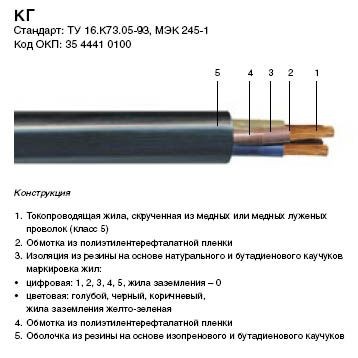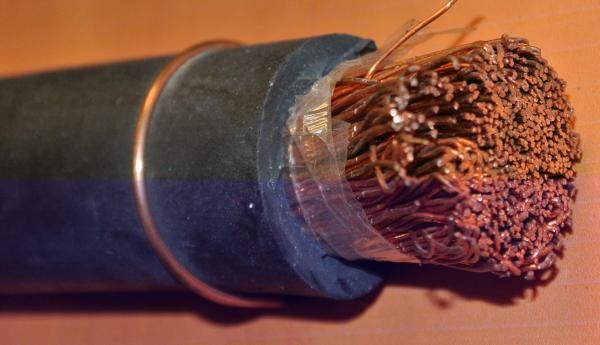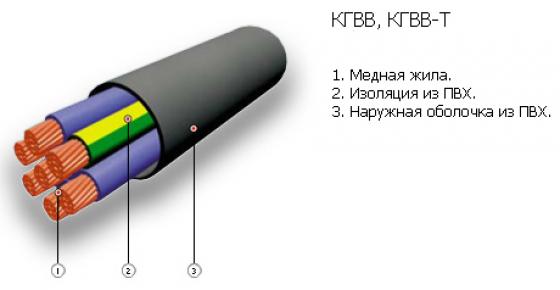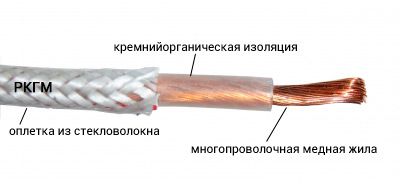Sections of the site
Editor's Choice:
- How to unlock ariston washing machine
- Pros and cons of LED lighting
- Pulse relay: device and connection
- How to calculate the illumination of a room with LED lamps?
- Plastic box - do-it-yourself aesthetic view of electrical wiring
- Electricity consumption of a warm floor: electric and film
- Installing a pump in a well: how to properly install pumping equipment
- Electrician Toolkit Overview
- How to choose a water heater: the most complete list of evaluation criteria
- 1 acoustics on the example of Sven SPS-860 and Realtek ALC889 codec
Advertising
| KG cable - technical specifications with classification |
|
The KG power cable has a fairly wide range of applications. Most often it is used as a welding cable, and in electrical wiring. Therefore, it is designed for voltages of both 380 volts and 660. On the market, this power cable is presented in the form of one-, two-, three-, and four-wire wires. Usually four-wire - these are three phases and one ground loop. In this case, the grounding conductor is smaller in diameter than the phase conductors. So, let's look at the KG power cable - technical specifications, what materials it is made of and recommendations from experts. Cable constructionMarking KG stands for "flexible cable". Therefore, the name itself already indicates that rubber is present in the composition of this product. In fact, this is a rubber sheath that acts as insulation. In this case, RTI-1 rubber from natural rubber or RTI-2 rubber from butadiene rubber can be used. Between the sheath of each core and the rubber insulation, a special film of polyethylene terphthal is laid, which protects the entire product from sticking together of two materials. And this will definitely happen in its absence, because the cable will heat up during operation. By the way, some manufacturers replace the protective film with talc or a special powder. The cores themselves are also in a rubber sheath. True, it uses a different kind of it. This is RShT-2 or RShT-2KhL. This is an important classification that determines in which climatic region the KG cable will be used. The first option is recommended for use in regions with a temperate climate, the second in cold areas. We add that the basis of rubber is isoprene. Sometimes manufacturers add yarn to the braid. If the cable Kg will be used in a climatic zone with tropical conditions, it is recommended to choose a product in which an antiseptic is added.  The core itself is a wire twisted from copper wires. Tinned copper. The wires have the fifth bending class, that is, a sufficiently high class that guarantees a large number of bends. Some manufacturers guarantee that their product can be folded and unfolded up to 30,000 times.
MarkingManufacturers use two types of core marking: digital and color. In the first case, numbers from one and above are used, while the ground loop is indicated by zero. Three main colors are used in color marking: brown, blue and black. Ground wire - yellow-green.
AdvantagesThe main advantages of this cable brand are:
True, there are some limitations. For example, for the connection of welding machines, mobile or portable tools, the technical characteristics of the consumers must be taken into account.
We add that when connected to a DC network, its voltage should not exceed 1000 volts. If all these indicators are taken into account during the operation of the KG cable, then it will last for four years. 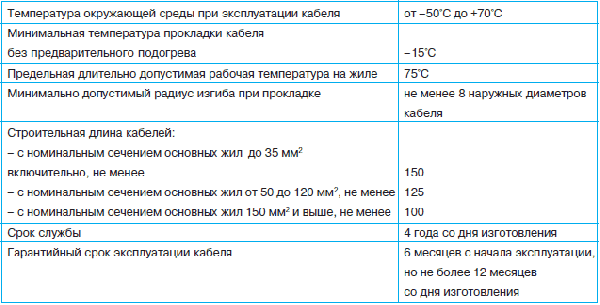 Dimensional indicatorsAll cable products are divided by the number of cores in the product. It has already been mentioned above that the KG cable (with any technical characteristics) is subject to this classification. But there is one dimensional indicator that determines the power that this cable can withstand. This is the cross section (area) of the vein.
As mentioned above, the ground wire is always one order of magnitude smaller than the phase wire. For example, CG 3×6+1×4. That is, the decoding here is as follows - three phase conductors have a cross section of 6 mm², grounding 4 mm².
Temperature indicatorsThis is one of the important parameters that affects the life of the cable itself. In their mass, KG cables can be operated in the temperature range from minus 40C to plus 50C. But there is a special abbreviation that helps to determine in which climatic region which cable is best to use.
As for resistance, the following are taken into account: a wire length of 1 km, an ambient temperature of + 20 ° C, a transmitted current power of 2.5 kW with an oscillation frequency of 50 Hz. And with all this, the resistance should be 50 mΩ. When testing a single-core conductor material, it must be immersed in water. If all these parameters converge, then the maximum heating temperature will be + 75C. If there is an increase in temperature, then something is wrong in the cable: either the wires have broken, or the insulation has leaked.
And one more important addition is the length of the product, depending on its section.
ModificationsThere are several models in the KG cable group. For example, with the CGVV. Its design uses non-rubber, and polymer insulation, in particular, polyvinyl chloride. Therefore, KGVV has a long service life - up to 25 years. Usually they are connected to large units and mechanisms powered by alternating or direct current. For example, with the help of KGVV, excavators in quarries, cranes and other mobile mechanisms are connected. The polyvinyl chloride sheath provides a fairly wide range of temperature conditions: from minus 50C to plus 50C. Therefore, the KGVV cable is not limited by any climatic conditions. As for voltage networks, the KGVV cable can operate on alternating current with an oscillation frequency of 60 Hz and a voltage of 0.66-1.0 kW. In a DC network with a voltage of 1.0-1.5 kW. And one more important point - if the CGVV is laid in one line without additional plumes, then it is practically non-flammable.
The next modification is RKGM. It is decoded like this:
Purely constructively, the RKGM wire consists of cores (copper wires), silicone rubber as insulation, glass fiber is a braid, impregnation of silicone varnish. Now the rest of the technical characteristics of the RKGM:
Typically, the RKGM cable is used in any networks to connect any mechanisms and devices. It can be laid over the air, because the RKGM cable is resistant to precipitation, solar radiation, and wind (shock) loads. The only requirement is the absence of contact with aggressive chemicals and oils. So when connecting the RKGM to the equipment, you will have to pre-examine it for the absence of oil stains. Otherwise, you will have to eliminate the oil leak and clean the surfaces of the devices. Like all power cables, RKGM must be accurately matched to the current load. Related posts: |
New
- I am a big tea lover. I especially respect green
- Ivan-tea with the addition of mint The chemical composition of the plant
- What is useful wheat porridge for the body
- Recipe: Soy Schnitzel - An excellent and tasty substitute for meat during Lent
- How to make ginger tea
- Coconut manna: benefits and harms, recipes with organic product Coconut paste how to use
- "Healthy" vegetable oils - a possible cause of obesity
- Adnexitis: causes, symptoms and treatment of the disease
- Herpes during pregnancy. Types, symptoms, treatment. Treatment of herpes during pregnancy Ointment for herpes during pregnancy
- What is pink catharanthus and how to care for it?

